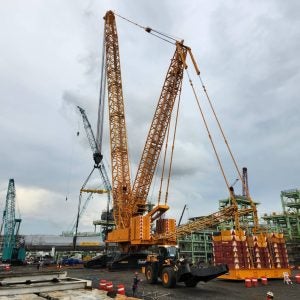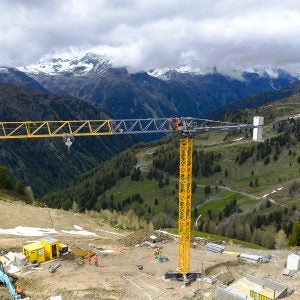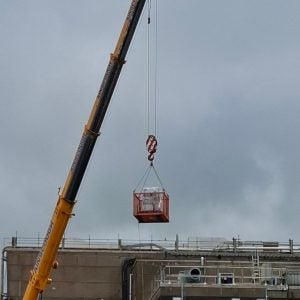Private consumption growth is expected to slow notably in 2008 as households begin to rein back their spending to consolidate their rapid debt accumulation of the last few years. The current consumer boom has been driven partly by cheap credit. Consequently, housing indebtedness has grown at an alarming rate, encouraged by rising home prices and low interest rates. The prolonged residential property boom has boosted mortgage borrowing and consumer credit to fund spending on household goods.
In addition, Global Insight also expects a notable slowdown in the pace of residential construction. Growth will also be limited by weaker export growth in 2008, hurt by the appreciation of the Euro, which will compound already weak external competitiveness, coupled with softer domestic spending across the Eurozone and the United States.
Spanish construction activity is set to slow at a sharp rate. The Spanish housing market is being enveloped by oversupply. The latest indicators suggest that demand for newly-built properties is falling at a time when the number of properties being constructed is high. In addition, planning applications, building permits, and residential construction starts weakened appreciably during 2007. We do not anticipate an imminent collapse of house prices, but we do accept that the conditions are in place for them to start falling from the second half of 2008.
House prices rose by 9.1% in 2006 compared with rises of 12.8% in 2005 and 17.2% in 2004. House-price inflation slowed further in 2007, but remained above consumer price inflation with demand for housing holding at a moderately solid level. Global Insight expects house prices to level off by mid-2008 and then start falling from the latter stages of 2008, heralding a period of markedly weaker construction activity. Importantly, we expect to see some very sharp price drops in regions which contain popular tourist areas. Spain leads the residential tourism market in the European Union (EU). In the long run, increasing demand for second homes due to the favorable climate, developed infrastructure, and superior lifestyle will contribute to residential construction growth. However, in the short run, Spain is exposed to slowing Eurozone economies that will limit demand for such luxuries. Nevertheless, demand for housing in city centres is expected to be more resilient with price drops likely to be more modest.
Similarly, we do not anticipate an imminent collapse of the property market, but we do believe the conditions are in place for the property market to slow steadily in the next few years.
Housing demand is still being supported by the arrival of over four million immigrants since 2000 and the strongest labour market since 1979. In addition, interest rates (both nominal and real) are still low compared with past norms.
Indeed, Spain’s demographics are more favourable compared with most of Europe and therefore should be less of a constraint to growth. Global Insight’s latest population forecasts show that the working-age population will continue to grow throughout the forecast period. This is partly due to the steady inflow of migrants into Spain. The statistical office (INE) reports that the immigrant population has grown by nearly 420,000 per year since 1998 to stand at approximately 7% of the total population in 2004. Its population projections assume a continuation of substantial inflows of immigrants, stabilising at 250,000 persons per year as of 2010, up from the previous projection of 60,000 persons per year between 2010 and 2050. This will limit the rise in the dependency ratio of the elderly to 33 percentage points (compared with 38 percentage points in the previous projection) by 2050.
Should there be a collapse of the Spanish property market, it would hit the economy hard. Construction activity has been an important engine of growth in the past nine years, contributing around one percentage point per year to overall real GDP growth, and it now accounts for 15.7% of real GDP. In addition, the construction sector has been a major source of new jobs, creating 186,000 of the 774,000 new employment opportunities that arose in 2006. This implies that the sector directly employed 2.5m workers in 2006, while many others were employed in related services.
Healthy government finances, coupled with strong economic growth, have allowed the government to increase both state pensions and spending on public services while introducing income-tax cuts in 2007. In addition, increased funds have been allocated for education and research and development (R&D), which is the first step in addressing the sluggish labor productivity performance in recent years. A key factor has been the lack of strong incentives to raise productivity, and problems arising in the education and the training system. These hamper R&D activities and the absorption of new technologies.
Meanwhile, equipment investment is set to slow from 2008 because of diminishing upgrading or replacement needs and weaker economic growth.
Construction spend
Spending in the construction sector will grow at a compound annual growth rate (CAGR) of 2.3%, from $155.3bn in 2006 to $195.3bn in 2016. Steady population growth, improving income levels, demand for commercial and industrial buildings, and necessary investments in infrastructure will drive rather benign growth. Near term problems with the housing market suggest that growth over the next five years will be slower than that over the following five.
Indeed, real spending growth in the residential sector will average only 1.6% over the next five years as the excess supply is worked out of the system. In the longer run, real residential construction growth should approach two percent, but a reappearance of the recent boom is highly unlikely given Spanish economic fundamentals.
A look at the composition of the Spanish construction market highlights the potential for weakness. In 2006, fully half of construction activity occurred in the residential sector with only a quarter of investment accounted for by private nonresidential structures. As the housing sector settles in for a period of weakness, the industry as a whole will need to find new opportunities for growth.
Spending in the nonresidential structures sector increased from $34.8bn in 2005 to $37.4bn in 2006-7.5% growth-due to increased demand for office space resulting from commercial and industrial expansion. However, nonresidential structure spending will slow to a CAGR of 1.8%, from $37.4bn in 2006 to $44.7 billon in 2016, driven by tourism and the service sector. Indeed one of the surprises of the Spanish housing boom was how little it translated into nonresidential strength over the extended time period. While housing accelerated at an average 6.4% rate over the past five years, nonresidential structural growth was closer to five percent.
Like much of Europe, Spain is a services-oriented economy. As such, most nonresidential structure demand will be for office space, although the need to modernise and improve labour productivity will also put upward pressure on new or extensively refurbished industrial space.
The climate, history, food and other amenities for which Spain is renowned will continue to drive the tourist trade. This may be on hold for the short term as the Eurozone economy slows and the weak dollar dampens tourist visits. However, in the medium to long run, growth in the tourism industry will increase demand for such nonresidential structures as restaurants, hotels, and theatres, leading to an increasing number of construction projects while driving growth in overall investment spending.
Weaker consumer spending will limit new store construction which will limit commercial construction opportunity. Additionally, the strong Euro will limit the competitiveness of European manufacturing, a problem compounded for Spain by its relatively weak productivity. Hence, industrial plant expansion and construction will also offer limited growth potential.
Real spending in the nonresidential infrastructure sector increased from $36.6bn in 2005 to $39.6bn in 2006, registering growth of 8.2%, attributable to increasing investments in public works and infrastructure. The Spanish government plans to continue infrastructure investments in various sectors, such as transport, public health, and energy, driving growth in nonresidential infrastructure, which will expand at a CAGR of 3.3%, from $39.6bn in 2006 to $57.7bn in 2016.
The government has launched major projects in the transportation sector, such as the Transport and Infrastructure Strategic Plan 2005-2020, and there have been total investments worth approximately $303.24m (EUR241.39m at the average exchange rate of 2006) in segments such as roads and railways. This will fuel spending in nonresidential infrastructure. The communications industry will play a major role in infrastructure growth through the expansion of existing mobile broadband and GSM networks in rural areas.
Nevertheless, the future for Spanish construction looks less bright than its recent past. Note that the expectation is for a deceleration of growth, not an outright contraction. The best opportunities will lie within the infrastructure segment, which has a large component of public funding. Construction related to energy infrastructure was a prime beneficiary of the expansion, however, over the next few years the opportunities will move toward transportation investment.






